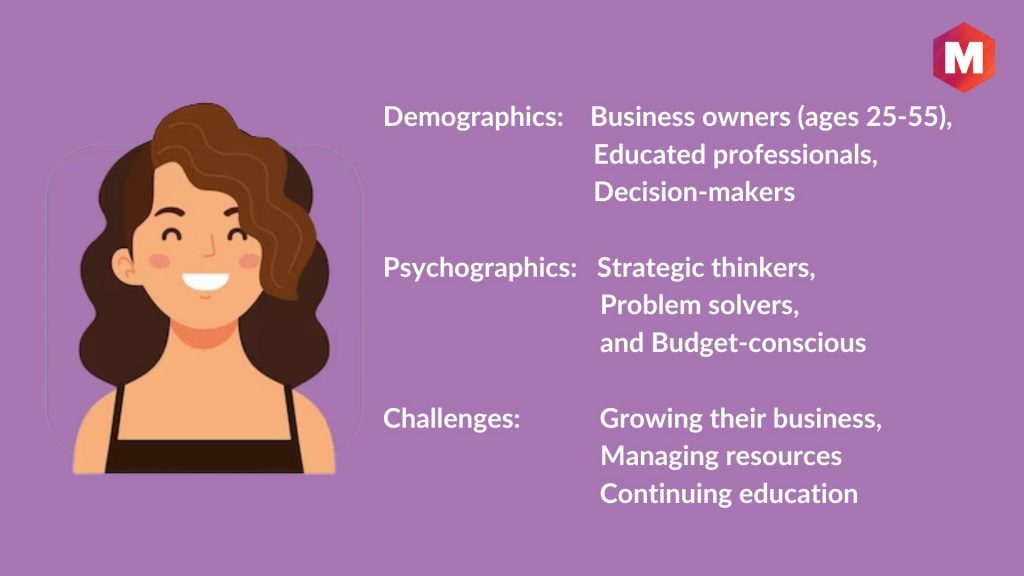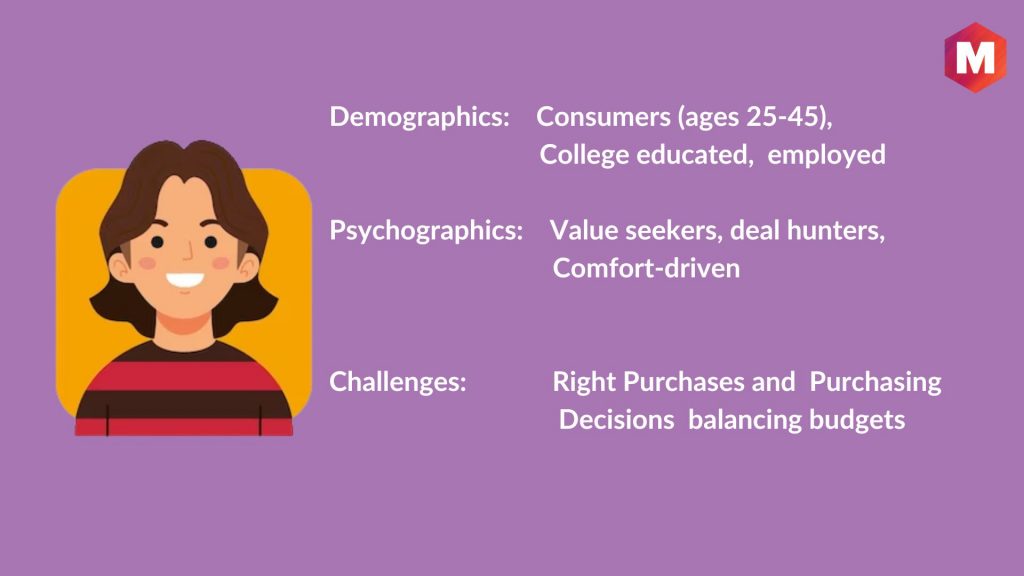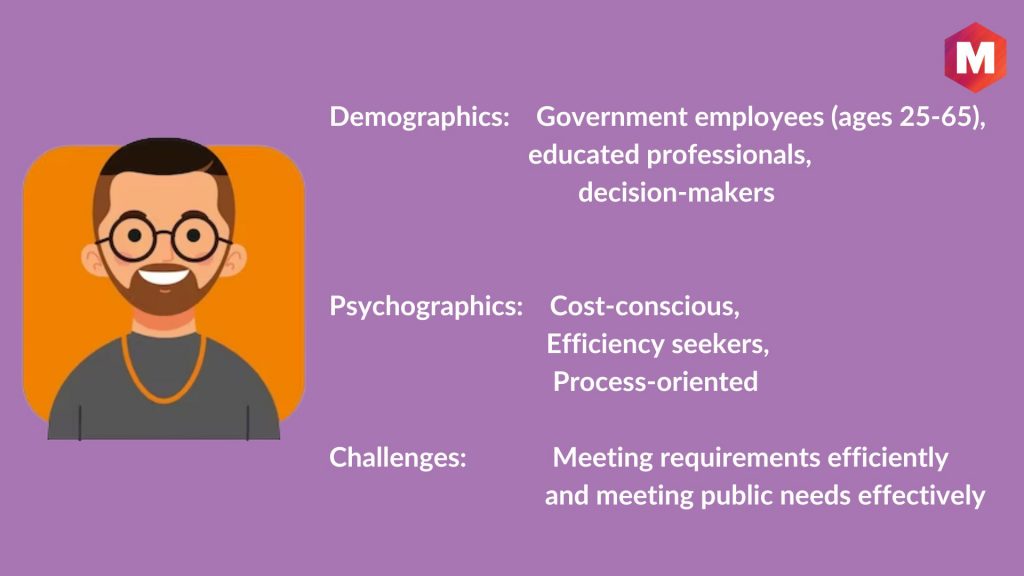An Audience profile is a target audience profile with a list of all the important characteristics of the targeted audience members who show some potential to the companies. It helps in creating result-driven buyer personas.
Most companies create audience profiles of people who show the characteristics of a potential buyer. These accurate audience profiles are important for companies to evaluate before they initiate their marketing campaigns.
Table of Contents
What is an Audience Profile?
An audience profile is a comprehensive summary of key data related to a buyer persona who appears to be an ideal customer for a company. Audience profiling encompasses essential information that helps companies understand their potential customers better and target the most profitable audience segments.
To be more specific, a target audience profile could consist of information about the audience’s demographics and characteristics, such as –
- Age
- Gender
- Socioeconomic status
- Occupation
- Geographic location
- Interests and hobbies
- Consumer behavior
- Online activity
- A preference for fair competition
These characteristics are important for the business to understand who could be potential customers of its products and services.
The audience profile contains much information about the particular individual the companies consider a potential customer. Audience profiling includes segmentation, messaging, engagement strategies, and measurements.
- Audience profiling information can relate to age, location, gender, income profile, etc. Nowadays, this audience profile is also sectioned into various segments.
- These groups are based on similar behavior, enabling the companies to tailor the activities of the various groups based on marketing efforts. This way, the companies can easily reach their various audience segments. This builds accurate audience profiles, mainly those who show potential for giving the biggest ROI, the return on investment.
- The audience profile allows companies to determine their customers’ ideal target market. It is more like a guide for companies.
This is because, with the help of the right audience profile, companies can understand what their customers are looking for, their demands, how much they are willing to pay, and what they expect from a particular product.
7 Steps of Creating An Audience Profile
Audience profiling is complicated, but it can do wonders for the company if done correctly. Now, there are the following steps that complete the whole process of audience analysis and profiling:
1) Choose Campaign Goals
When embarking on any marketing endeavor, the first step should be focusing your team’s attention on the desired outcomes. Brainstorm with yourself and those around you to determine what objectives profiling can help accomplish for your business.
2) Do Your Research
To ensure success, every successful marketing campaign or project must set objectives and leverage research to collect data and determine the best course of action. Different factors involved in this step are:
- Analytics
- Qualitative Data
- Demographics
- Psychographic Information
- Channel Preference, etc
3) Create Segments Based On Research
After surveying your audience, you can use the data collected to sort and organize individuals into small groups. Doing this will give you valuable insights about who they are, what they need, and how best to craft a successful marketing strategy that speaks directly to them!
4) Develop Messaging For Each Segment
Now that you have performed segmentation of your target market, it’s time to create the perfect messages for each one. Using our example of a teen clothing store and its vast potential customer base, we now have the moment to dig deeper and decide how best to use marketing messaging to reach these leads.
5) Engage with the Audience on the Right Channels
Crafting the perfect campaign message is useless if your target audience doesn’t notice it, so post on the right social media channels. This will increase your visibility and help you reach your desired demographic.
6) Monitor Your Campaign Performance
It is essential to measure your campaigns’ performance to ensure they have the best possible segmenting, messaging, and channels. Please take advantage of data sources such as analytics and qualitative insights that you used to create the initial profile for targeted campaigns; use them to monitor every campaign’s progress.
7) Review and Change Your Profile
As market trends change and public perspectives transform, so should your profile. Over time, as you roll out new products or services or integrate fresh technology and content channels into the mix, it is essential to adapt certain profile segments accordingly. This way, you can ensure that you keep up with shifting industry norms to remain successful.
Why is Audience Profiling Important?
Building a compelling audience profile is essential for creating a profitable market for your business. It helps in running personalized marketing campaigns.
With this knowledge, you can discover the preferences of the people you are selling to, such as what content resonates best with them and which marketing techniques capture their attention most effectively.
Knowing these details gives insight into how to build accurate audience profiles and craft messages for future campaigns that will directly appeal to and convert potential customers.
Understanding your audience is akin to getting acquainted with a person. You can inquire about their passions, preferences, and dislikes, which only serves as surface-level information. A true bond comes from knowing what makes them tick and understanding who they are.
Audience profiling is all about building meaningful connections with specific groups and demographics that directly affect your business. By doing so, you can create effective strategies to leverage these key players and maximize the growth of your audience persona for your company.
Why Should You Use an Audience Profile For a Marketing Campaign?
Designing a comprehensive audience profile allows you to create meaningful, tailored, personalized marketing campaigns and strategies for your products and services. It is essential to remember that only some products or services will be suitable for some customers within its target market.
For instance, some of your customers may only need product descriptions or eBooks, while others won’t have any use for these items at all. Although we still reach out to businesses and agencies looking for eBooks, our marketing strategies must be tailored more specifically.
Instead of generic campaigns, it is wise to craft specialized ones with offerings that appeal directly to each target audience segment. Doing so will likely yield higher conversion rates since there’s no longer a guessing game regarding what appeals most to them.
What Information Should an Audience Profile Include?
To establish a compelling audience profile, ensure that it encompasses the following key points:
1. Demographic information: Personal characteristics such as location, age, education level, job title, and salary are all considered.
2. Psychographic information: Details such as personality traits, hobbies, attitudes, beliefs, or lifestyles are all included in this assessment.
3. Goals, challenges, or pain points: To maximize the efficacy of this section, identify your audience’s goals, struggles, or sources of distress regarding utilizing your product and service.
4. Values: What do your target consumers prioritize? Think bigger-picture motives like “having a connection to nature,” “hanging out with others,” “feeling at home somewhere,” or even being able to have autonomy in the workplace.
5. Preferred channels: Understanding where your target audience spends the most time is critical. Understanding their preferences and which channels to focus on will also be crucial to connecting with them.
6. Preferred content type(s): Once your content is found, you must know what format best serves your audience. Should you present it as an e-book, blog post, or case study? Or perhaps offer a podcast or video instead? Deciding on the appropriate format for the intended purpose is essential to ensure that audiences are effectively informed.
7. Buying behavior: Study your target customers’ buying habits and uncover which channels will most successfully draw their attention.
Thus, when companies understand their customers’ behaviors, it will become much easier to send them messages and paid advertising to convince them to buy the products.
The Audience Profiling Process
Audience profiling is an essential tool that helps marketers find and understand their ideal customers. Businesses can make their marketing strategies much more effective by breaking the audience up into small groups, sending messages that are relevant to these groups, keeping their attention, and then tracking the results. This process can be broken down into four essential steps:
1. Segmentation: Putting the audience into groups
- Segmentation is the first step in crowd profiling. In the past, this meant putting possible customers into groups based on basic demographics. However, improvements in technology and data analysis tools have changed this. Platforms like the Global Web Index (GWI) now give marketers more information about how people act, what they like, and how they feel about things. This helps them divide their groups more effectively.
- These days, segmentation looks at more than just demographics. It also looks at psychographics and behavioral data to understand possible customers fully. With these insights, you can make more accurate buyer personas, which will help you learn more about your customers and what material will appeal to them. Check out our in-depth guide for more information on how to make effective characters.
- Keeping your audience insights current is important as customer tastes and habits change. Staying up with the latest news will ensure your marketing remains useful and practical.
2. Messaging: Crafting Compelling Content
- After dividing your target into groups, the next step is to clarify your message. Part of this involves discovering your target groups’ feelings about your brand and what makes them buy from you.
- To write effective messages, you need to know the problems each group of people in your audience faces and how your product or service can help them. Sharing success stories and being open about your brand’s benefits can make your message more powerful.
3. Engagement: Maximizing Your Reach
- Knowing who your target is is not enough. You must also know where and how to reach them. Learning how people use different platforms, devices, and channels can help ensure that your content placement plan has the most impact.
- Using these insights to guide your marketing, you can increase your business’s visibility and attract more people to interact with it. Our specialized book has tips on how to get people more involved with different types of marketing.
4. Measurement: Understanding the Impact
- Careful measurements are used to determine the effectiveness of crowd profiling. Using a single source for customer data makes it easier to monitor the effectiveness of your targeting strategies.
- Focus on data showing how real customers act on various platforms and devices. This method gives you a complete picture of how customers interact with your business over time.
- Keep an eye on this data and constantly change your plans based on it. Regular analysis helps you improve your methods to stay in line with your audience’s changing tastes.
Best Tips for Effective Audience Profiling
Audience profiling is the process of generating an accurate audience profile. It is one of the basic building blocks for any company formulating an appropriate marketing strategy.
It helps companies understand the customer journey and track consumer behavior, which requires more time and money to invest. Audience profiling allows companies to focus on customers’ activities and analyze their buying behaviors.
1) Create Customer Personas From Your Profile
Want to gain more insight into your customers’ and clients’ minds? Try developing a customer persona for each audience segmentation of your target audience. These personas are fictitious stories about potential buyers who could one day interact with your brand if they were real. Personas will help you better comprehend the needs, wants, and habits of all types of people who may be interested in what you have to offer!
2) Give Your Audience a Chance To Respond
To gain greater insight into your audience’s qualitative and psychographic data, allow them to share valuable feedback with you. Make it easy for them by offering interactive options such as polls, quizzes, or submission forms on any social media platforms or content you post – this will help collect comprehensive information about who they are and what they want from you.
3) Create Your Profiles With Data
Outshine your competition with comprehensive keyword research and a precise audience profile. Download Google Analytics or other content analysis tools for free to get ahead of the game!
How does Audience Profiling help?
It is an excellent tool for companies to target only their potential audience and then approach them based on their buying habits and behaviors. Audience profiles help a company in a variety of ways. Some of these are listed below-
1. When a company generates a well-defined audience profile, it can solve customers’ problems by knowing exactly what they need and how much they can pay.
2. A properly prepared audience profile helps companies build strong relationships with their customers, gaining a strong base of loyal customers and leading to brand loyalty.
3. The audience profile helps companies understand customers’ problems and struggles. Once this is known, companies can successfully tailor their marketing to customers’ needs and wants.
4. The audience profiles also help companies grow their brands with consumer testimonials, uplifting their reputation in the marketing field.
Advantages of Audience Profiling for a Business
1. The audience profile is beneficial for the ROI. If the audience profiling is done with the right approach, all the time and money that the company invests will yield a higher ROI value for the company.
2. It helps companies keep up with their competitors. With technological advancement, digital marketing has been taking over the whole business industry. Since audience profiles are also one of its parts, companies that use this get ahead of their competitors.
3. It helps in understanding the customers’ expectations. With the increasing competition, customers’ expectations are also increasing. To keep up with this, companies must create an audience profile to know what customers demand or need.
4. It is a reliable method for gathering information. It is a reliable method that helps companies gain insights into their target segment of customers. This way, the companies will learn more about the wants and needs of the customers and then plan their marketing strategies accordingly.
5. Good audience profiling helps companies create 3D insights into their customers. This is an important aspect for any company as it helps them remain ahead. By creating a 3D insight, companies can learn more about the customers’ desires, attitudes, behaviors, and wants and needs.
How Can Audience Profiling Increase Conversion?
Audience analysis saves you time, money, and effort by helping you focus on a smaller group of people.
Once you know your target audience, you can use that information to boost your sales rates.
Planning your strategy without knowing much about your audience is like setting a big marketing trap in the desert: it will waste your time and money with few results.
Once you know your audience, tailoring your story to them based on your research can help you target your ads, which is a smart move that will lead to a higher return on investment.
Audience Profile Examples
1. B2B Audience Profile
- Demographics: Business owners (ages 25-55), educated professionals, decision-makers
- Psychographics: Strategic thinkers, problem solvers, and budget-conscious
- Challenges: Growing their business, managing resources, continuing education
2. B2C Audience Profile
- Demographics: Consumers (ages 25-45), college educated, employed
- Psychographics: Value seekers, deal hunters, comfort-driven
- Challenges: Making the right purchases and purchasing decisions and balancing budgets
3. B2G Audience Profile
- Demographics: Government employees (ages 25-65), educated professionals, decision-makers
- Psychographics: Cost-conscious, efficiency seekers, process-oriented
- Challenges: Meeting requirements efficiently and meeting public needs effectively
Conclusion!
Knowing this information before launching a product will guarantee a sure shot at success for any company. With quantitative data and the help of the audience profile, companies get to know their audience much better. This is quite a step-by-step guide and an essential thing to do if one wants to sell their products at large levels.
By creating an audience profile beforehand, companies will be aware of the demands of existing customers and the needs of their target. Thus, companies will try to launch only those products that can fulfill their customers’ requirements. In this way, the audience profile is necessary for the marketing industry.
Liked this post? Check out the complete series on Marketing





